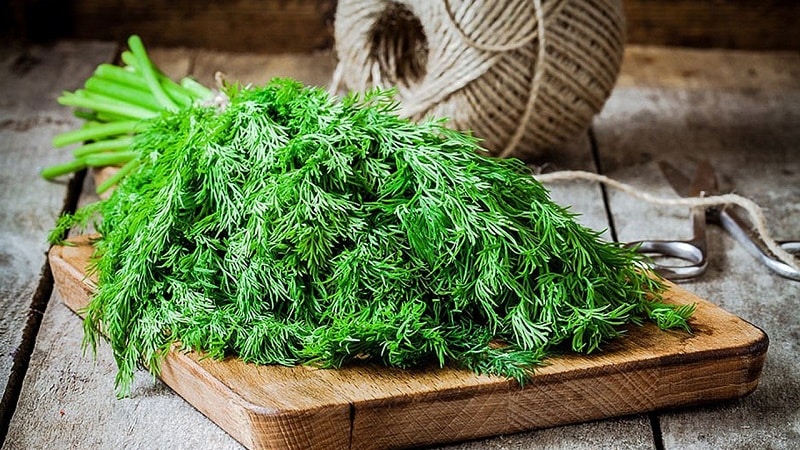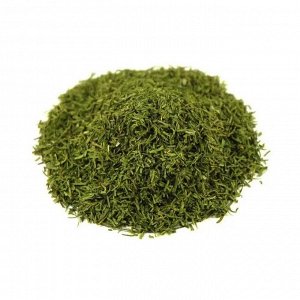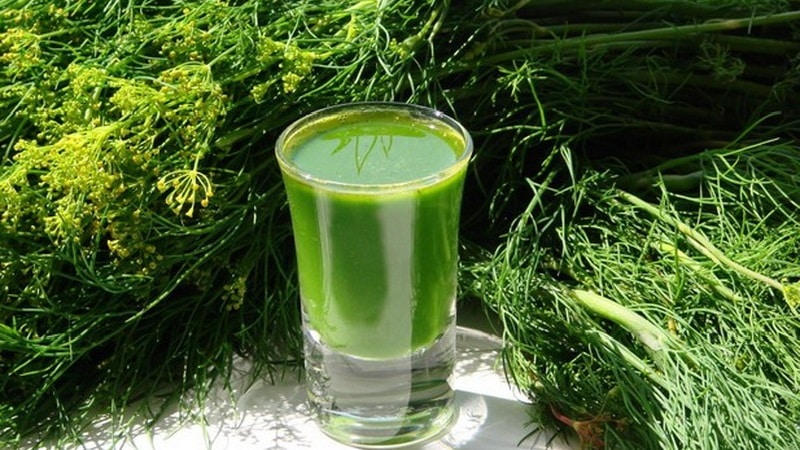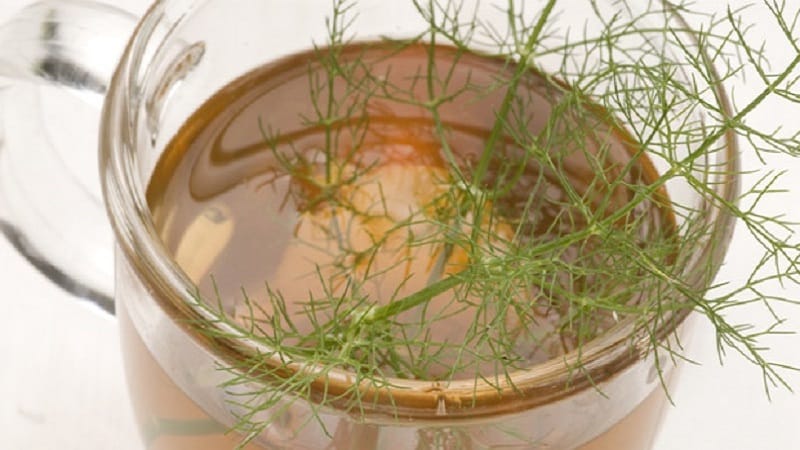Dill for cleansing the brain: how to take it and contraindications
Few people know that dill is used not only in cooking, but also in medicine for the treatment and prevention of a number of diseases. In addition to improving appetite and normalizing intestinal function, the plant reduces headaches, increased excitability and is used for atherosclerosis.
Chemical composition and structure of the plant

Dill is an annual of the Apiaceae family, reaching a height of 120 cm. The plant has dissected pinnate leaves and a branched stem, at the top of which there is an inflorescence in the form of a complex umbrella with a diameter of up to 15 cm. The fruits are ovoid, gray-brown two-seeded seeds.
Reference! Dill contains a large amount of vitamins B, PP, K, carotene, biological antioxidant E and ascorbic acid.
100 g of fresh plant contains:
- 750 mcg (83% of the daily value) of vitamin A - responsible for cell regeneration, full growth of the body and visual acuity;
- 0.06 mg (3.5%) vitamin B1 - normalizes the functions of nerve cells and muscles;
- 0.3 mg (15%) vitamin B2 - inhibits skin aging and age-related changes, maintains normal visual acuity, stimulates brain activity, tones, increases appetite;
- 1.7 mg (11%) vitamin E - protects cells from oxidation, reduces their oxygen consumption, participates in protein synthesis, and helps strengthen the immune system;
- 85–100 mg (132%) vitamin C - stimulates collagen production, strengthens the walls of blood vessels, increases resistance to bacteria and viruses;
- 1.57 mg (8%) of vitamin PP - is responsible for stabilizing nervous activity, regulating metabolic processes and the formation of hemoglobin.
Dill is enriched with macroelements responsible for the vital functions of the body.
Per 100 g of plant there are:
- 38–66 mg (6.5%) phosphorus;
- 592–738 mg (27%) potassium;
- 111–394 mg (23%) calcium;
- 50–163 mg (8%) sodium;
- 28–70 mg (12%) magnesium.
100 g of dill contains a sufficient amount of microelements: manganese, iron, copper and zinc to cover the bulk of the daily requirement for them.
Nutritional value of dill per 100 g:
- calorie content - 43 kcal;
- fats - 1.1 g;
- proteins - 3.5 g;
- carbohydrates - 4.9 g;
- water - 86 g;
- dietary fiber - 2.1 g.
The fruits contain essential oil (carveol, perillyl alcohol, dillapiol, α-limonene, β-pinene, etc.), coumarins, organic acids, protein, and the seeds contain essential and fatty oils. The herb is rich in flavonoids.
What are the benefits of dill?

Beneficial features plants for women:
- reduction of pain during menstruation;
- stabilization of hormonal processes;
- partial or complete relief from or alleviation of menopausal symptoms;
- improvement of well-being, relief from toxicosis and anemia (for pregnant women);
- increasing the amount of milk in lactating women;
- calming neuroses, normalizing sleep.
Dill for cosmetic purposes reduces skin pigmentation, improves complexion, eliminates inflammation and fine wrinkles.
Properties for men:
- dilation of blood vessels, cleaning their walls from plaques in atherosclerosis;
- improvement of blood supply;
- increase in potency;
- normalization of the functions of the genitourinary system;
- reducing the likelihood of prostate inflammation.
For newborn babies:
- preventing gas accumulation;
- reducing the likelihood of colic.
The components of dill essential oil and flavonoids have strong antioxidant properties, they have anti-aging and anti-tumor potential.
Dill reduces the level of total cholesterol, strengthens the walls of blood vessels, maybe useful for people with atherosclerosis, hyperlipidemia (increased amount of lipoproteins in the blood), early stages of hypertension.
The healing properties of dill for the brain
The components of the plant regulate coronary blood circulation, cleanse blood vessels, relieve muscle spasms and lower blood pressure.
A study on rats revealed a decrease in oxidative stress and inflammation, a decrease in the risk of cerebral infarction, and the neuroprotective properties of dill extract.
Since the plant contains phytoestrogens, its essence can improve cognitive abilities in postmenopausal women.
In what form to use
It is possible to use various parts of dill (flowers, seeds, stems, leaves) both fresh and dry.
Fresh herbs and dry

It is better to use greens in the summer, since at this time it is possible to grow the crop yourself or buy it without the presence of harmful substances. Daily consumption of fresh dill is recommended: it is added to soups, side dishes, salads, and snacks.
The leaves of the dry plant are poured with boiling water in a ratio of 1-2 tsp. in 200 ml of water, infuse and drink in the evening as tea.
Juice and infusion
Dill greens are washed, dried naturally and crushed using a juicer or meat grinder. The juice is squeezed out of the resulting mixture.
Treatment is carried out in three courses according to the following scheme:
- 100 ml 3 times a day for a week;
- break - 10 days.
Infusion from the annual plant is taken in courses of 10 days with the same interval. To prepare 2 tsp.dry or 3 tsp. - fresh dill herb pour 1 tbsp. boiling water (+80°C), leave for 10–15 minutes, squeeze, filter. The recommended dose is 3 times a day, 1/2 tbsp. Prepare the infusion for a day.

Seeds
How to prepare and take dill to cleanse brain vessels:
- Pour 200 g of dill seed into 2 liters of boiling water.
- Leave for 24 hours in a dark place.
- Take 3 times a day, 1 tbsp. l., 30 minutes before meals.
To achieve results, it is important to undergo treatment for 2 months, eliminating alcohol and fatty foods from your diet.
Tincture

Alcohol tincture recipe:
- Chop 100 g of fresh herb, put it in a jar or bottle and pour 1 liter of high-quality vodka.
- Seal and store in a warm, dark place for 1 month.
- After this, strain the tincture into another container and squeeze out the dill.
Take the product 3 times a day, before meals, adding a few drops to hot water. The course is 1-2 months.
Oil extract
How to make dill oil:
- Grind dry plant seeds, herbs in a coffee grinder or pound them in a mortar.
- Pour into a jar, filling it 2/3 full. Pour olive or sunflower oil to the top.
- Close tightly and leave to infuse for 1 month.
- Strain and pour into containers.
Store the finished product for no more than a year at room temperature in a dark place. Before use, the oil is diluted with boiled water in a ratio of 1:5, take 1 tbsp. l. after meals 4 times a day or added to prepared dishes.
Other
Liquid butter can be replaced with green sandwich butter. To do this, butter is mixed with garlic, dill and parsley and spread on whole grain bread.
Additional ingredients for cleaning vessels
Preparation medicinal products based on dill involves the addition of various components.
Valerian
The plant contains essential oils that have a beneficial effect on the nervous system. Tincture of dill and valerian has a number of beneficial properties:
- normalizes the functioning of the cardiovascular system;
- reduces blood pressure;
- improves blood circulation;
- reduces myocardial tension and stress on the heart muscle;
- strengthens neurons, serves as a prevention of ischemia;
- relieves spasms well;
- relieves anxiety and helps you sleep better.
Valerian should not be taken by women in the 1st trimester of pregnancy and children.
Honey
The glucose contained in honey helps strengthen the myocardium and dilate the coronary vessels. Daily use of the product leads to:
- reduction of swelling;
- expansion and cleansing of blood vessels;
- eliminating pain in the heart, stabilizing its rhythm;
- improving the condition of the nervous system.
Folk recipes
There are many recipes based on dill to relieve spasms, strengthen the walls of blood vessels, and reduce cholesterol levels.

With sea buckthorn oil
To strengthen the blood vessels of the brain, dill seeds (200 g) are washed, dried and mixed with ½ liter of preheated sea buckthorn oil. The mixture is poured into a glass container and left for 20 days, then filtered. The finished product is taken 15 ml 3 times a day, the duration of treatment is 40 days.
With mint and immortelle
The infusion has choleretic, anti-inflammatory and antispasmodic effects, relieves increased excitability, and protects cells from oxidative stress.
To prepare it, take immortelle and mint herbs, dill seeds in a ratio of 1:1:1. 5 g of the mixture is poured into 300 ml of boiling water (+80°C), left for 15–20 minutes. Take 100 ml 3-4 times a day. The course of treatment is 1 month.
Based on dill + honey/valerian
Decoctions, alcohol tinctures and powdered preparations are prepared from valerian, dill and honey for cleaning blood vessels.
Decoction
Components:
- 1 tbsp. l. valerian root (crushed);
- 2 tbsp. l. honey;
- 1 liter of water;
- ½ tbsp. dry dill seeds.
Valerian root is poured with water, brought to a boil, reduced heat and simmered under the lid for 20–30 minutes. Pour the broth over dill seeds, cover and infuse. After 3 hours, strain the mixture, add honey and stir well. Take 3 times a day, 30 minutes before meals, 1 tbsp. l.
Alcohol tincture
Components:
- 1 part dry valerian root;
- 20 parts vodka;
- 1 tsp. honey;
- 1 part dill seeds.
Place the plants in a glass container and fill with vodka. Leave for 1 month in a dark place at room temperature, shake occasionally. After the due date, filter the tincture and add honey. Take 20–60 drops, adding them to hot water, 2 times a day: morning and evening.
Important! The recommended course of treatment is 1 month. To prevent the body from getting used to the therapeutic effect, a break of 7–14 days is required.
The maximum effect from taking medicinal products is possible only by alternating recipes and simultaneously giving up bad habits.
Possible harm and contraindications
Dill is not recommended in a number of cases:
- exacerbation of various kidney diseases;
- hypotension;
- the presence of stones in the kidneys, gall bladder, etc.;
- intestinal or stomach ulcer;
- pancreatitis.
Due to the high content of essential oils, dill is not recommended in large dosages during pregnancy and breastfeeding.
What do the doctor's say
According to experts, cleaning and strengthening blood vessels with preparations prepared from parts of dill is an effective solution as a preventive measure and in the absence of contraindications. It should not replace conservative treatment. The first improvements in taking vascular cleaning products, according to reviews, are observed after 2-3 weeks.
It is important to consult with your doctor first. You cannot take decoctions and infusions simultaneously with any medications.
Conclusion
Although dill has many beneficial properties (from regulating intestinal motor activity to reducing total cholesterol levels), it can only be used as a therapeutic agent under the supervision of a doctor. If the slightest signs of deterioration appear, treatment is stopped immediately.